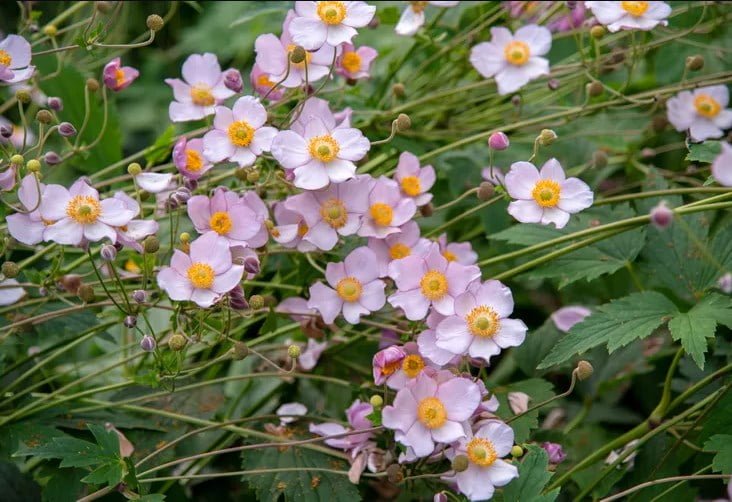Commonly known as windflower or Japanese thimbleweed, Japanese anemone (Eriocapitella x hybrida) is a herbaceous perennial with graceful branching flower stems and white, pink, or purple blossoms. Blooming in late summer and early fall, the flowers present as poppy-like single or double blooms. This is an easy-to-grow, low-maintenance flower.
The plant is deer and rabbit resistant. However, it is toxic to humans.
Japanese Anemone Care
Japanese anemone prefers full sun—the flowering stems can flop if given too much shade.
Give this flower moist, neutral to slightly alkaline soil with good drainage.
The perennial spreads through wirey rhizomes to form new colonies.
The flowers attract pollinators and make great cut flowers.
Light
Japanese anemones prefer full sun, 6 or more hours of direct sunlight a day, but can tolerate partial shade. Planting in the shade reduces bloom production and causes flower stems to flop over.
Soil
The plants prefer organically rich, neutral to slightly alkaline soil. Humus-rich soil provides the nutrients they need to thrive and multiply.

Water
Good drainage is a must because the roots of the plant may not survive winter with wet feet. The plants do best in moist soil and should be watered well during dry conditions because they do not tolerate drought.
Temperature and Humidity
Japanese anemones grow well in USDA zones 4a-8b. It is best to mulch the roots in colder climates. In hotter zones, provide a bit of afternoon shade to prevent foliage from burning. Humidity is not a factor unless it is exceptionally high which can cause powdery mildew.
Fertilizer
Japanese anemones do not usually require fertilization if the soil has plenty of organic matter.
Types of Japanese Anemones
There are several cultivars with ‘Honorine Jobert’ as one of the most popular, as it blooms for 5 to 8 weeks in late summer into early fall.
Eriocapitella x hybrida ‘Alba’: Produces single white blooms for around 24 days.
Eriocapitella x hybrida ‘Alice’: Produces pale pink, semi-double blooms for 50+ days.
Eriocapitella x hybrida ‘Avalance’: Produces white double blooms for around 40 days.
Eriocapitella x hybrida ‘Honorine Jobert’: One of the most popular Japanese anemone cultivars, it has been found in gardens dating to the mid-1800s. Produces white single to semi-double blooms for about 30 days and has received the Award of Garden Merit from Britain’s Royal Horticultural Society.
Eriocapitella x hybrida ‘Königin Charlotte or Queen Charlotte’: Produces a pale pink semi-double flower for around 24 days and has received the Award of Garden Merit from Britain’s Royal Horticultural Society.
Pruning
These perennials do not require pruning other than deadheading. However, after the foliage begins to die back, you can remove it completely.
Propagating
Japanese anemones are best propagated by dividing an existing clump or taking root cuttings.
Dividing Existing Plants
Divide existing plants in spring as new growth appears.
Use a spade to dig up the clump and a sharp knife to divide the rootball into sections.
Replant the pieces about 24 inches apart in humus-rich soil and water well. The plants may not bloom the first season after division but will be identical to the parent plant when they bloom the next year.
Taking Root Cuttings
Take root cuttings in fall when the plant is fully grown.
Use a spade or trowel to dig down beside the plant to find a healthy, fleshy root.
Use the spade or pruning shears to snip off the root.
Cut the root into small pieces about 2 inches long and lay them horizontally onto a try of damp, well-draining potting soil and cover lightly. The root will form side roots and shoots, which will be the new plants.
Keep the soil moist but not wet and sheltered during cold temperatures.
When plants are established and securely rooted, transfer them to the garden and space about 24-inches apart where they should flower in a couple of years. The anemone will be the same cultivar as the parent plant.
How to Grow Japanese Anemones From Seed
Japanese anemone seeds are readily available in seed catalogs. But if you want to give collecting seeds a try, harvest seeds from the seed pods and direct sow them into your garden in the fall and just barely cover them with soil. The seeds should germinate in the spring and the plants will bloom in their second year. If you gather seeds from your existing hybrid plants, you may not end up with the same bloom color.
To start seeds indoors, they should be planted 4 to 6 weeks before the last frost so plants will be ready for transplanting in the spring. The small plants can be transplanted outdoors when daytime temperatures are reliably in the upper 50-degree Fahrenheit range.
Fill a seed starting tray with growing mix and water until the mixture is moist but not standing in water.
Sprinkle Japanese anemone seed on top of the growing mix, sprinkle a thin layer of the seed starting mix on top of the seeds, and press the soil down gently with your hand.
Place the seeds under a grow light and keep the tray at a temperature of 50 degrees Fahrenheit until they germinate in about 20 to 30 days.
Thin the plants when the seedlings are about 2 inches high and continue growing under the grow lights.
Transplant the seedlings into 2- to 3-inch pots and begin to harden off the seedlings when daytime temperatures are in the upper 40s. Bring the plants indoors at night or anytime frost threatens.
Plant in the garden 24 inches apart when temperatures are reliably in the upper 50 to 60-degree Fahrenheit range.
Overwintering
Since the foliage of Japanese anemone often remains green in warmer hardiness zones or sheltered locations, there are no special overwintering methods required. In colder climates, mulch the roots well.
Common Pests and Plant Diseases
Japanese anemone plants are susceptible to leaf spot, powdery mildew, downy mildew, and rust. Root rot can happen if the soil is not well-draining. Common pests affecting this plant include caterpillars, slugs, and nematodes.
How to Get Japanese Anemone to Bloom
Japanese anemone blooms from mid to late summer into mid fall. If your plant is not blooming, it probably needs more sunlight or nutrients. Move the plant to a sunnier location or prune other plants to provide more light. Add organic matter to the soil to increase nutrition.
Japanese anemone can become invasive if allowed to spread unchecked. The problem is easily solved by removing new growth in the spring. Another issue is floppy flower stalks. If this is a problem, the plant can be staked or planted in a sheltered spot away from strong winds.


